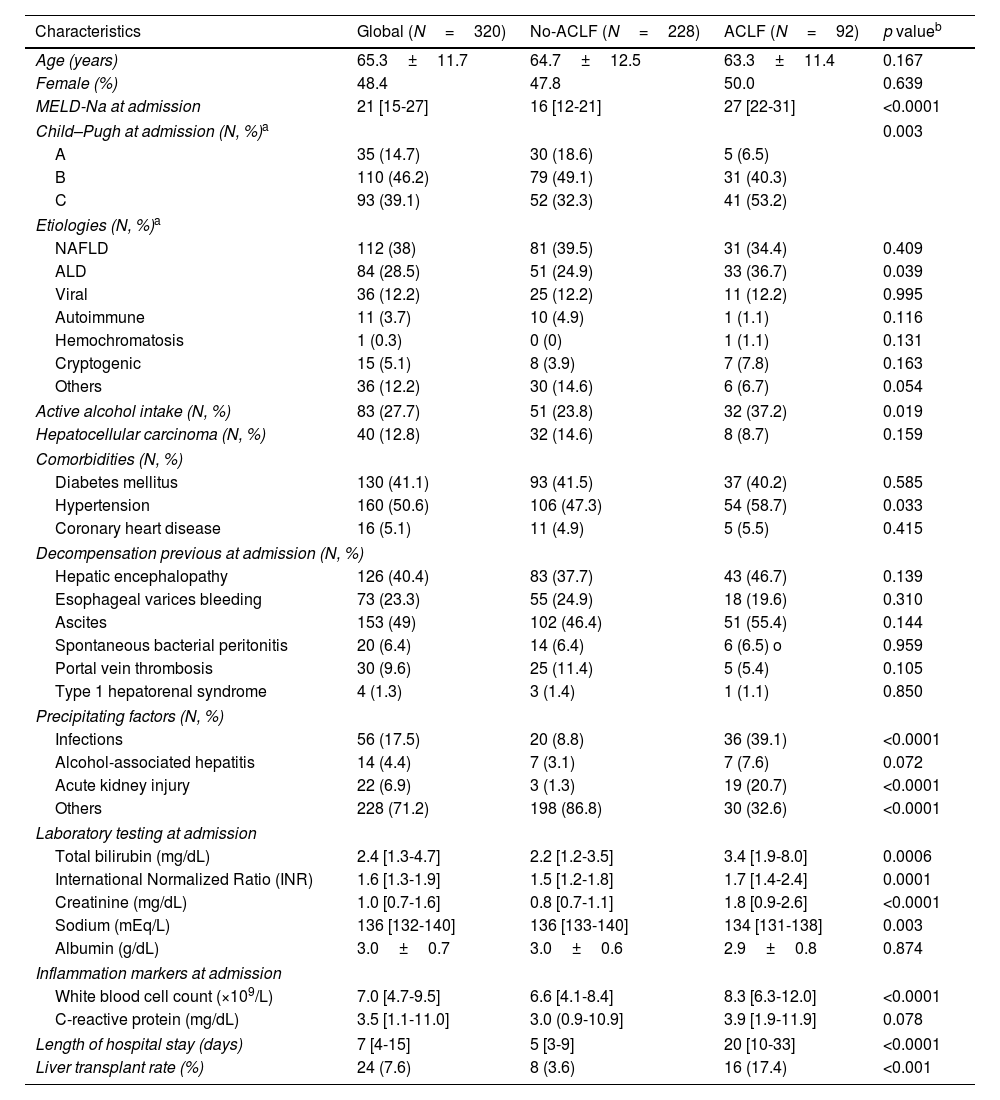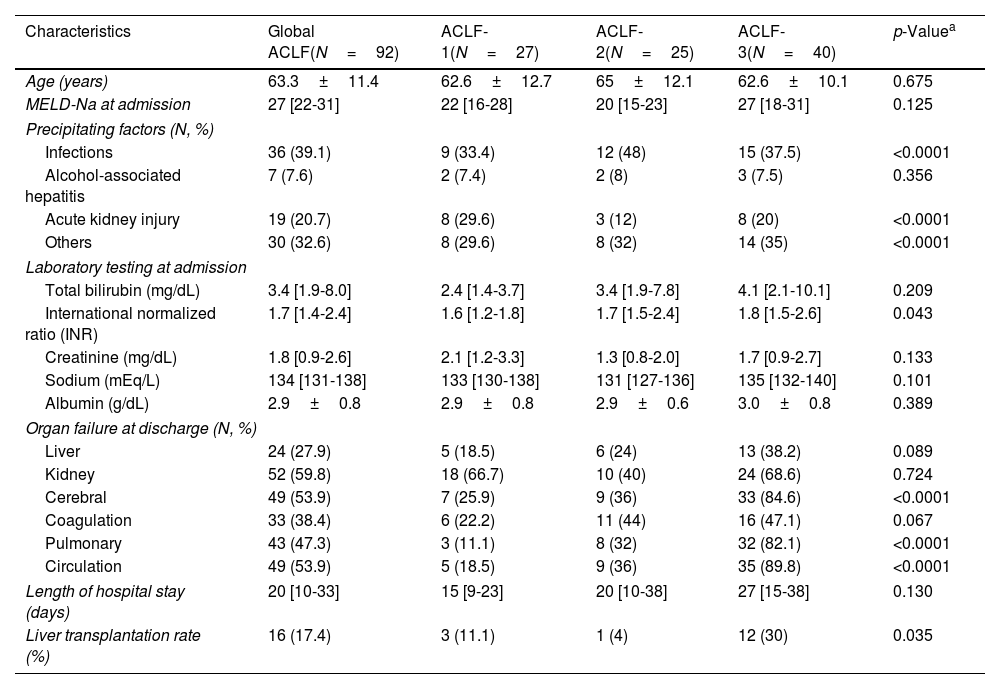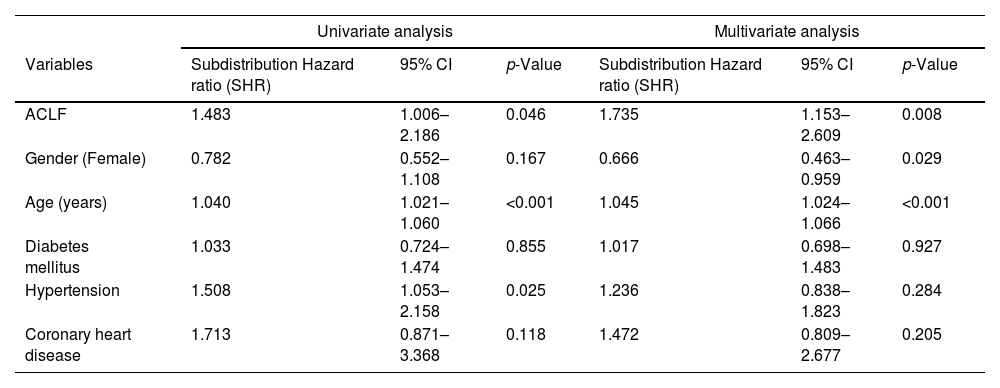Acute-on-chronic liver failure (ACLF) is a severe clinical entity associated with elevated short-term mortality. We aimed to characterize patients with decompensated cirrhosis according to presence of ACLF, their association with active alcohol intake, and long-term survival in Latin America.
MethodsRetrospective cohort study of decompensated cirrhotic in three Chilean university centers (2017-2019). ACLF was diagnosed according EASL-CLIF criteria. We assessed survival using competing-risk and time-to-event analyses. We evaluated the time to death using accelerated failure time (AFT) models.
ResultsWe included 320 patients, median age of 65.3±11.7 years old, and 48.4% were women. 92 (28.7%) patients met ACLF criteria (ACLF-1: 29.3%, ACLF-2: 27.1%, and ACLF-3: 43.4%). The most common precipitants were infections (39.1%), and the leading organ failure was kidney (59.8%). Active alcohol consumption was frequent (27.7%), even in patients with a prior diagnosis of non-alcoholic fatty liver disease (NAFLD) (16.2%). Ninety-two (28.7%) patients had ACLF (ACLF-1: 8.4%, ACLF-2: 7.8%, and ACLF-3: 12.5%). ACLF patients had a higher MELD-Na score at admission (27 [22-31] versus 16 [12-21], p<0.0001), a higher frequency of alcohol-associated liver disease (36.7% versus 24.9%, p=0.039), and a more frequent active alcohol intake (37.2% versus 23.8%, p=0.019). In a multivariate model, ACLF was associated with higher mortality (subdistribution hazard ratio 1.735, 95%CI: 1.153-2.609; p<0.008). In the AFT models, the presence of ACLF during hospitalization correlated with a shorter time to death: ACLF-1 shortens the time to death by 4.7 times (time ratio [TR] 0.214, 95%CI: 0.075-0.615; p<0.004), ACLF-2 by 4.4 times (TR 0.224, 95%CI: 0.070-0.713; p<0.011), and ACLF-3 by 37 times (TR 0.027, 95%CI: 0.006-0.129; p<0.001).
ConclusionsPatients with decompensated cirrhosis and ACLF exhibited a high frequency ofactive alcohol consumption. Patients with ACLF showed higher mortality and shorter time todeath than those without ACLF.
La insuficiencia hepática aguda sobre crónica (ACLF, por sus siglas en inglés) es una entidad clínica grave asociada con una elevada mortalidad a corto plazo. Nuestro objetivo fue caracterizar a los pacientes con cirrosis descompensada según la presencia de ACLF, su asociación con la ingesta activa de alcohol y la supervivencia a largo plazo en América Latina.
MétodosEstudio de cohorte retrospectivo de cirróticos descompensados en tres centros universitarios chilenos (2017-2019). La ACLF se diagnosticó según los criterios EASL-CLIF. Evaluamos la supervivencia mediante análisis de riesgo competitivo y de tiempo hasta el evento. Evaluamos el tiempo hasta la muerte usando modelos de tiempo de falla acelerada (AFT).
ResultadosSe incluyeron 320 pacientes, mediana de edad de 65,3±11,7 años, y el 48,4% eran mujeres. Un total de 92 (28,7%) pacientes cumplieron criterios de ACLF (ACLF-1 29,3%, ACLF-2 27,1%, y ACLF-3 43,4%). Los precipitantes más frecuentes fueron las infecciones (39,1%) y la principal insuficiencia orgánica fue la renal (59,8%). El consumo activo de alcohol fue frecuente (27,7%), incluso en pacientes con diagnóstico previo de enfermedad de hígado graso no alcohólico (EHGNA) (16,2%); 92 (28,7%) pacientes tenían ACLF (ACLF-1: 8,4%, ACLF-2: 7,8% y ACLF-3: 12,5%). Los pacientes con ACLF tenían una puntuación MELD-Na más alta al ingreso (27 [22-31] frente a 16 [12-21], p<0,0001), una mayor frecuencia de enfermedad hepática asociada al alcohol (36,7% frente a 24,9%, p=0,039), y una ingesta activa de alcohol más frecuente (37,2% frente a 23,8%, p=0,019). En un modelo multivariado, ACLF se asoció con una mayor mortalidad (cociente de riesgos instantáneos de subdistribución 1,735, IC del 95%: 1,153-2,609; p<0,008). En los modelos AFT, la presencia de ACLF durante la hospitalización se correlacionó con un menor tiempo hasta la muerte: ACLF-1 acortó el tiempo hasta la muerte en 4,7 veces (relación de tiempo [TR] 0,214, IC 95%: 0,075-0,615; p<0,004), en ACLF-2 4,4 veces (TR 0,224, IC 95%: 0,070-0,713; p<0,011), y en ACLF-3 en 37 veces (TR 0,027, IC 95%: 0,006-0,129; p<0,001).
ConclusionesLos pacientes con cirrosis descompensada y ACLF presentaban una alta frecuencia de consumo activo de alcohol. Los pacientes con ACLF mostraron una mayor mortalidad y un tiempo más corto hasta la muerte que aquellos sin ACLF.















